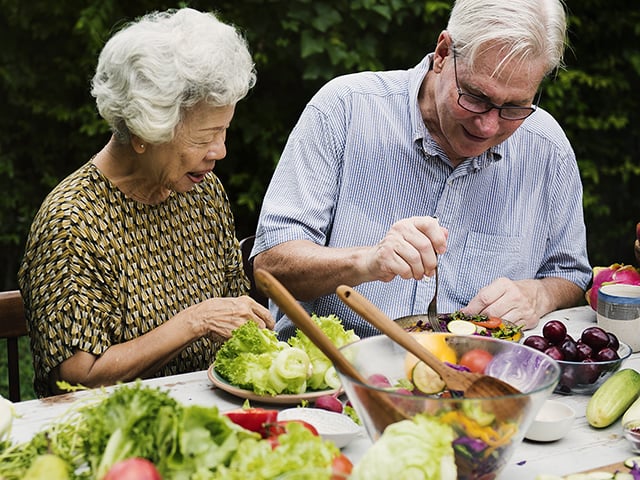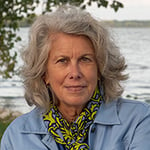Published: March 1, 2024
 We like to add a personal touch to our appearance with a favorite headband or hat. We personalize our home by decorating with cherished artwork and heirlooms. We personalize our dinner table too, with colorful placemats and a vase of fresh flowers.
We like to add a personal touch to our appearance with a favorite headband or hat. We personalize our home by decorating with cherished artwork and heirlooms. We personalize our dinner table too, with colorful placemats and a vase of fresh flowers.
So during National Nutrition Month, how about personalizing our healthy dinner plate?
What Is National Nutrition Month?
Every March, the Academy of Nutrition and Dietetics focuses attention on healthy eating through its National Nutrition Month® campaign. An underlying theme to each year's campaign is to create nutritious meals that meet your cultural and personal food preferences. After all, if you don't like a certain food, you're unlikely to incorporate it into your meals.
"America is a cultural melting pot, so you can't expect everyone's food choices to look the same," said registered dietitian nutritionist Su-Nui Escobar, a national spokesperson for the Academy of Nutrition and Dietetics in Miami, Fla. "Eating is meant to be a joyful experience. As supermarkets increasingly diversify their shelves to meet the needs of their customers, it's becoming easier to create nutritious meals that align with a variety of cultural preferences."
Speaking of cultural foods, this month might be a good time to try healthy foods from cultures other than your own. Here are some Academy-recommended recipes for Asian, Middle Eastern and Native American dishes.
Tips from Kendal at Oberlin’s Community Nutritionist
“Creating a nutritious meal is not a one-size-fits-all plan,” says Sue Campbell, RD, LD. “Yet, there are some common, good-sense tips to consider when building a healthy plate.”
Here are five MyPlate recommendations Sue passes on from the U.S. Department of Agriculture:
- Make half your plate fruits and vegetables. Include dark-green, red and orange vegetables to maximize the nutritional benefits.
- Make a quarter of your plate whole grains. Choose breads, cereals, crackers and noodles made with 100% whole grains. Brown rice, bulgur, millet, amaranth and oats count as whole grains, too. Look for cereal fortified with B12 and ones with a high-fiber content.
- The last quarter of your plate should be your protein choice. Eat a variety of foods from the protein group each week, including seafood, nuts, beans, peas and lentils, as well as lean meat, poultry and eggs.
- Switch to fat-free or low-fat milk, yogurt and cheeses. Older adults need more calcium and vitamin D to keep bones healthy. Include three servings of these daily. There are many lactose-free options of calcium-fortified beverages available.
- Stay well hydrated. This is huge! Hydration can play a big role in our daily function and cognition and affects our energy levels.
Aging and Healthy Eating
As you grow older, your taste buds and food preferences may change. For sure, though, your body changes.
- Older adults generally need fewer calories. However, their nutrient needs are just as high or higher than when they were younger. That’s why eating nutrient-rich, whole foods becomes extremely important;
- Bowel-related issues, including constipation and diverticular disease, can occur as you age. You can help protect yourself by increasing your fiber intake;
- Aging is linked to muscle loss, thinner skin and reduced stomach acid. Your ability to recognize hunger and thirst may also be reduced as you age;
- Eating a protein-rich diet could help fight sarcopenia, the age-related loss of muscle and strength.
Many older adults seek the guidance of a nutritionist like Sue to make dietary changes. Some also turn to a weight loss program to get rid of unwanted pounds.
Kendal at Oberlin resident Agnes Bacon did both and is happy with the results. “I eat small quantities of lots of things and feel so much better,” says Agnes, who lost 12 pounds.
Agnes’ personal plate is now comprised of mostly vegetables (“very few you can name that I don’t like”), fish, chicken and fresh fruit. Less likely to be found on her plate are red meat, pasta and creamy sauces. She uses less salt and instead seasons her food with salsa, lemon, black pepper, paprika and other spices.
She says her cooking style is simple because she mainly supplements and complements meals from Kendal dining services.
As for her namesake, “I love bacon, but I hardly eat it.”
Nutrition Is a Big Topic at Kendal
Eating healthy food is a staple on the Kendal at Oberlin campus. So is a fruitful conversation about nutrition, whether it’s during committee meetings, across dining room tables or at community-wide forums.
Affiliates of The Kendal Corporation have Registered Dietitians on staff, and the organization is examining ways the communities can work with the “Food as Medicine” movement. Some Kendal affiliates emphasize meals from the Mediterranean diet (high in fish, fruits and vegetables, low in red meat and trans fats) and strive to offer a variety of vegan and vegetarian options.
You may also enjoy Diet Consideration for a Healthy MIND >>>
This blog was originally published in 2021 and was updated in February 2024.
Feed Your Body Right: Nutritional Needs After 50
As you age, having a healthy and balanced diet will help you look and feel your best while helping prevent many serious health issues. Learn how in our free guide.
 In the past, Molly Kavanaugh frequently wrote about Kendal at Oberlin for the Cleveland Plain Dealer, where she was a reporter for 16 years. Now we are happy to have her writing for the Kendal at Oberlin Community.
In the past, Molly Kavanaugh frequently wrote about Kendal at Oberlin for the Cleveland Plain Dealer, where she was a reporter for 16 years. Now we are happy to have her writing for the Kendal at Oberlin Community.
About Kendal at Oberlin: Kendal is a nonprofit life plan community serving older adults in northeast Ohio. Located about one mile from Oberlin College and Conservatory, and about a 40 minute drive from downtown Cleveland, Kendal offers a vibrant resident-led lifestyle with access to music, art and lifelong learning.




